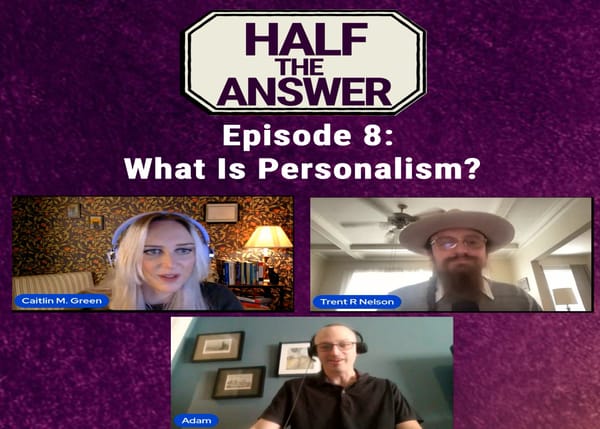Once and Future Liberal Institutionalism
When conservatives want to burn down the system.

For sixty years, our culture has had a strong anti-institutional bent. We can date it to the student protests at Berkeley in 1964, which spread to universities across the country and kicked off the hippie “counterculture” of the 1960s. This rebellion against “the establishment” was all the more influential because it took hold on campus, among students who would later enter and eventually run the very institutions they were clamoring to tear down. This injected an anti-establishment, anti-institutional outlook into the mainstream of the American left—and into the mainstream of American culture.
No, this was not always dominant, and many of the counterculture kids came to accept and even embrace the institutions as they grew into positions of authority. But myriad examples capture the anti-establishment flavor of our era. Consider the anti-Vietnam War protest movement and the 1971 leak of the Pentagon Papers, which was intended to highlight the failures of the Department of Defense. Or remember the 1975 film One Flew Over the Cuckoo’s Nest, which cast mental health institutions as cruel and oppressive. Most of us have grown up in a culture where institutions are routinely portrayed as corrupt and oppressive, where the very term “institutional” is a pejorative, and everybody wants to tear down “the establishment.” We have all been told repeatedly that the whole system is out of order, which reminds us of the histrionic Al Pacino excesses in which this was expressed.
You may object that we needed criticism of the institutions and sweeping reforms, and that’s certainly true. After all, one of the systems the anti-establishment crusaders helped tear down was Jim Crow. But as necessary as many of these reforms were, the side-effect was that this filled the culture with a broad mistrust of institutions as such.
There have always been populist and anti-elite trends in American culture, but they have never been as mainstream as they have become in our time. The Great Awokening of the 2010s, for example, was based on the premise that every aspect of our society—the economy, politics, education, culture—is shot through with “systemic” injustices. The 1619 Project claimed that America was based on slavery from the very beginning, while police shootings in 2020 were considered grounds for abolishing policing itself as an unreformable enterprise. Police abolitionists were a small minority, but the slogan “defund the police” was widely adopted, with sympathizers all the way up to the top.
Yet something fundamental has changed in the last ten years. The right has also become anti-institutional. This has consequences few people have recognized, and it will require a lot of us to adjust our outlook and tactics.
Hippies of the Right
For most of our anti-establishment era, the urge to tear down the institutions was balanced by a conservative philosophy centered around preserving institutions. Conservatives were motivated partly by a desire to maintain the status quo, but also by a sincere conviction about the need for stable and continuous social institutions.
But in the past ten years, in the Trump era, the American right has not only adopted the larger cultural trend but become even more virulently anti-institutional and anti-establishment—and its attempt to tear down the institutions will be all the more effective because it is dressed up in the trappings of traditionalism.
Consider how the right has turned against key institutions it used to celebrate and defend: law enforcement, the military, and the intelligence services. These are now all denounced on the right as corrupt instruments of the “deep state,” and they are being specifically targeted for dismantling by Donald Trump’s most alarming appointments: Kash Patel for the FBI, Pete Hegseth at the Department of Defense, Tulsi Gabbard as Director of National Intelligence. Each of these people was chosen for their hostility toward the organizations they are now supposed to lead.
These selections also indicate what drove the right to turn against the institutions. Starting decades ago, conservatives began to feel shut out from the mainstream of the culture and its institutions, beginning with the universities and the media. For a while, they tried to either re-establish themselves in the universities or create alternative institutions—but those efforts largely failed. The big dividing line, in retrospect, was the Supreme Court ruling in favor of gay marriage in 2015. I saw its impact up close among conservatives, who saw it as evidence that they were comprehensively losing the culture war and the institutions had all turned against them.
At the time, The Federalist’s Ben Domenech called this “the post-apocalyptic culture war,” based on the premise that “the culture wars are over, and [conservative Christians] lost.” The goal was no longer to fight over control of the institutions, but to destroy them rather than let them fall into enemy hands. Donald Trump found the conservative movement in this mood and exploited it. He helped them openly embrace their new role as hippies of the right, as revolutionaries who want to burn the system down rather than conserve it.
This is their own imagery, by the way. A recent book by Heritage Foundation head Kevin Roberts, one of the architects of the Trump agenda as laid out in Project 2025, was originally slated to have a cover image of a lit match and the subtitle “Burning Down Washington to Save America.” Curiously, the book is titled Dawn’s Early Light, after the line from Francis Scott Key’s poem—yet the desire to burn down Washington would put Roberts on the side of the British invaders.
The phenomenon of a revolutionary conservatism is not as paradoxical as it may seem. Fascism was in part an adaptation of the political forms of Marxist revolutionary ideology to an opposing, reactionary agenda. It was a revolution not just against capitalism but against all elements of the modern world, including liberal political rules and institutions. Leaving aside questions about detailed parallels to fascism, today’s right is operating on the same general impetus.
“What Happened to You?”
We are in a long anti-institutional era that has reached its climax, in which even the supposedly conservative faction becomes anti-institutional and tries to tear down our whole social system. When you look at things this way, it explains a lot of things that are otherwise inexplicable.
As a veteran of the Tea Party movement, ten to fifteen years ago, I can now see how the remnants of a seemingly pro-freedom movement were so quickly co-opted by an anti-market authoritarian. In retrospect, the truly salient aspect of the Tea Party was not its nominal libertarian ideology, but rather its anti-establishment populism. This manifested not just in a hatred of the Obama administration but in an even more visceral hatred of the Republican Party “establishment.” What Donald Trump has offered is the prospect of seeing that establishment brought to heel—and it turns out that it doesn’t really matter all that much for what cause the establishment is brought down, so long as it is brought down.
Rand Paul is a bellwether of this change. His election to the Senate in 2010 seemed like a rapprochement between conservative and libertarian ideologies, but in retrospect, its main effect was to import into the Republican Party his father’s crackpot anti-establishment conspiracy theories, by way of characters like longtime Ron Paul booster Alex Jones.
Or consider how easily Trump knocked over the Libertarian Party. Many libertarians turned out to be motivated less by the intricacies of libertarian orthodoxy than by hatred of the establishment, for which goal Trump turned out to be the best, most effective vehicle.
This also explains the influence of pseudo-intellectuals like Curtis Yarvin. Those who attempt to examine his ideology will find that there is no “there” there. The only semi-coherent idea is his concept of “the Cathedral,” a pretentious way of rediscovering that there is a “mainstream” to the culture and things that are outside the mainstream. This makes no sense as a great intellectual breakthrough. All it accomplishes is to rephrase a radical anti-establishment attitude into conservative terminology.
This is also why old friends from the libertarian or conservative movements will ask some of us, "What happened to you?" or “Why did you change?” when our actual positions on the issues—trade, immigration, foreign policy, freedom of speech—haven’t changed at all, but theirs have. What they really mean is that they thought we, too, were supposed to be reflexively anti-establishment—so why are we defending norms and institutions?
From this perspective, the Great Awokening and Trumpism are not complete opposites, but in some ways competing versions of anti-institutionalism. In the peak years of “wokeness,” it was not pushed so much from the top down—Nancy Pelosi didn’t cancel anyone—as from the bottom up, by anonymous teenagers acting out their pain on Tumblr and making the establishment tremble. But the same thing is true of Trumpism. Senators are afraid of a blogger who calls himself “Catturd.” Rupert Murdoch seems terrified of his own viewers, who will readily abandon Fox News Channel for even more disreputable outlets like Newsmax or Infowars. Even Donald Trump is afraid of the forces he unleashed. He used to boast about supporting the development of covid vaccines, then followed his followers in turning against them.
Above all, this is why we see the left-to-right migration Matt Yglesias calls the “crank realignment.” Robert F. Kennedy, Jr. and a whole brigade of conspiracy theorists have transferred their loyalties to the party that is now more anti-establishment, more open to hearing that vaccines will kill you or that wifi causes cancer. And Republicans take these notions so seriously that they will give these conspiracy theorists power to destroy the FDA and the CDC.
What Would Chesterton Do?
This also explains why Democrats are floundering in the face of the MAGA takeover of Washington. They are used to seeing themselves as the anti-establishment party. You can see this in embarrassing episodes like Colorado Governor Jared Polis, New Jersey Senator Cory Booker, and Vermont Senator Bernie Sanders all volunteering support for RFK, Jr.’s crackpot ideas on medicine and diet. The “wellness” cranks may be realigning to the right, but many Democrats are still under their influence.
Liberals and Democrats are caught between two worlds—defending the establishment and often over-timidly clinging to its cautious norms—while still clinging to rhetoric about fighting the power and tearing down the establishment, which just feeds the populist surge on which Trump relies. They have been slow and reluctant to acknowledge that to be a liberal, in any meaningful sense, is to be in some important respects the conservative party in today’s world, the party that wants to defend the institutions.
And we really do need institutions. The reason you may find today’s anti-institutional right so dismaying is that they have rejected one of the best, most convincing arguments offered by their own ideology: Chesterton’s Fence. This is a cautionary tale offered by the conservative intellectual G.K. Chesterton about the “more modern type of reformer” who recklessly tears down a fence because he doesn’t see the use for it. Chesterton admonishes him to first find out why the fence was there in the first place, because it is likely it once served an important purpose—and may still do so.
Similarly, our institutions were built up for a reason. In their early days, all newspapers were biased and partisan, which is why we built up norms for professional media and fact-checking. People used to die from infectious diseases in astonishing numbers, especially children, so we built public health systems, scientific institutions, and vaccination programs. Global wars turned the early 20th Century into an apocalypse, so we built alliances and established international norms. We need someone to defend all of this against the “more modern type of reformer”—now on the right—who wants to tear it down. And we don’t just need to defend old liberal institutions but to build new ones designed to thrive in the digital era.
To be clear, criticism of institutions and the establishment is necessary and healthy. Our new institutions need to be liberal institutions, built to accommodate pluralism and tolerate challenges to groupthink. But the goal is to make it possible to reform institutions when they go wrong, not to tear them down and replace them with the whims of an authoritarian demagogue.
The question of how to do this is a difficult one, and it will require a lot of trial and error. But the first step is recognizing that it must be done. Now is the time to defend our institutions as fiercely as we can—and get ready to rebuild them after they get smashed to pieces.





